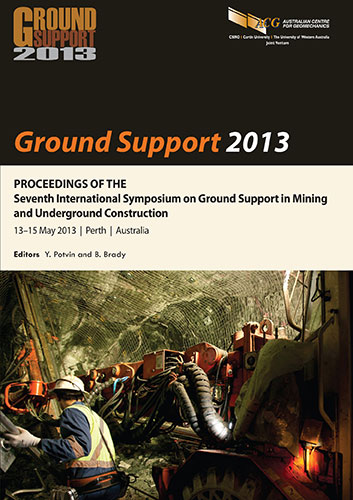Onsite visualisation of measured information in mining engineering for advanced risk management

|
Authors: Akutagawa, S; Komiyama, S; Kunimi, T; Takahashi, A; Izumi, C; Abe, R Paper is not available for download Contact Us |
DOI https://doi.org/10.36487/ACG_rep/1304_45_Akutagawa
Cite As:
Akutagawa, S, Komiyama, S, Kunimi, T, Takahashi, A, Izumi, C & Abe, R 2013, 'Onsite visualisation of measured information in mining engineering for advanced risk management', in Y Potvin & B Brady (eds), Ground Support 2013: Proceedings of the Seventh International Symposium on Ground Support in Mining and Underground Construction, Australian Centre for Geomechanics, Perth, pp. 645-656, https://doi.org/10.36487/ACG_rep/1304_45_Akutagawa
Abstract:
New sensors were developed for simultaneous monitoring and visualisation of risk conditions for mining applications to achieve an advanced safety management scheme using ‘colour of light’ as a key part of the technology. These sensors are designed and built based on the new monitoring concept called ‘Onsite Visualisation’ (OSV) and are capable of 1) sensing data and; 2) visually outputting the measurement results simultaneously by using Light Emitting Diodes (LED) for workers. This paper introduces OSV, and gives brief explanations of the light emitting devices developed so far. In Japan the OSV has been applied at nearly 40 locations where tunnels, slopes, bridges, open excavations etc. were monitored with light emitting sensors. The OSV was also applied successfully to improve safety management practices at Delhi and Bangalore Metro construction sites in India. The employment of the OSV enables real-time data processing and visualisation onsite, so that the state of deformation, strain, inclination, earth pressure, etc. can be grasped with no delay in time and is shown visually as the colour of light. The rational designed use of this method for mining could give us early warning signs, if any, and minimise risks not only during mining but also during the service time of all mining infrastructures. OSV, once embodied in the framework of safety management practices, could lead to a better understanding of potential risks and improved management of safety at both open and underground mining sites.
References:
Abe, R., Nishikiori, A., Akutagawa, S., Shinji, M., Izumi, C., Imamura, H., Nagano, S., Takahashi, A., Kamal, S., Sasaki, Y. and Minami, Y. (2012) Special Assistance for Project Implementation (SAPI) applying “On Site Visualization” and “Dust Monitoring” at Bangalore Metro construction sites, The Final Report: SAPI for Bangalore Metro Project utilizing Japanese ODA, Japan International Cooperation Agency, June 2011 to March 2012.
Akutagawa, S., Nomura, M., Yamada, H., Abe, R., Izumi, C. and Kusui, A. (2011a) New scheme for simultaneous monitoring and visualization of safety conditions at underground construction sites by using light emitting sensors, ITA-AITES World Tunnel Congress, Underground spaces in the service of a sustainable society and the 37th ITA-AITES General Assembly, 20–26 May, 2011, Helsinki, Finland.
Akutagawa, S., Nomura, M., Kusui, A., Yamada, H., Abe, R. and Izumi, C. (2011b) On Site Visualization as a new scheme for risk visualization and safety management for geomechanics applications, in Proceedings the 8th International Conference on Field Measurement in Geomechanics, Berlin, Germany, September 12–16 2011.
Akutagawa, S. (2010) On Site Visualization as a New Paradigm for Field Measurement in Rock Engineering, Proceedings of the 6th Asian Rock Mechanics Symposium, 23–27 October 2010, New Delhi, India, pp.KN34-KN45.
Akutagawa, S., Kusui, A. and Nomura, M. (2010) Light emitting sensors as new visual tool for rock structure monitoring, in Proceedings EUROCK 2010, 15–18 June 2010, Lausanne, Switzerland, pp. 609–612.
Akutagawa, S., Mori, S., Kusui, A. and Nomura, M. (2009) New concept for rock structure monitoring by light emitting sensors, in Proceedings 2009 Korea-Japan Joint Symposium on Rock Engineering, 22–23 October 2009, Suwon, Korea, pp. 347–356.
Nakamura, S., Abe, R., Akutagawa, S., Takahashi, A. and Kusui, A. (2010) Special Assistance for Project Implementation (SAPI) applying the monitoring method by On Site Visualization at Delhi Metro construction sites, The Final Report: SAPI for Delhi Metro Project utilizing Japanese ODA , Japan International Cooperation Agency, March 2010 to June 2010, September 2010.
© Copyright 2025, Australian Centre for Geomechanics (ACG), The University of Western Australia. All rights reserved.
View copyright/legal information
Please direct any queries or error reports to repository-acg@uwa.edu.au
View copyright/legal information
Please direct any queries or error reports to repository-acg@uwa.edu.au